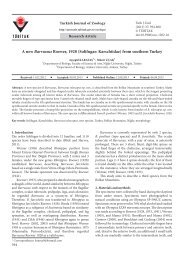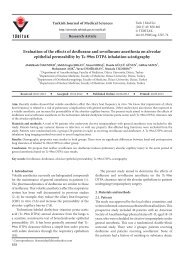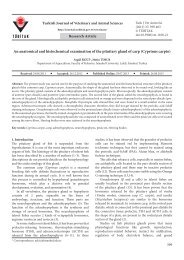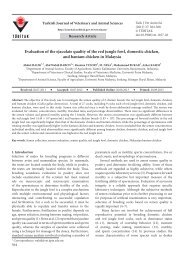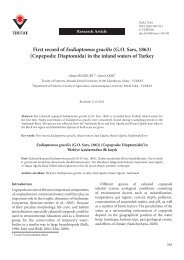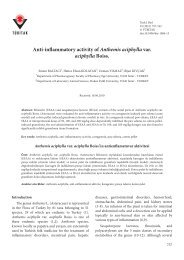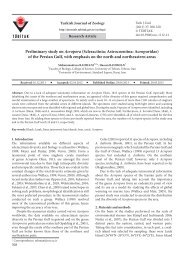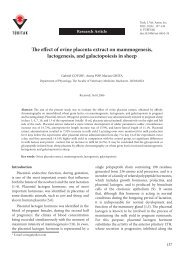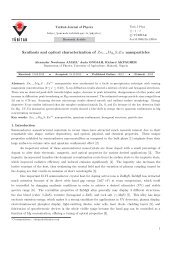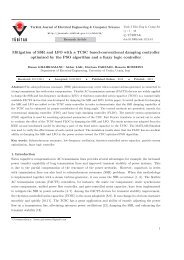Messinian forced regressions in the Adana Basin: a near ... - Tübitak
Messinian forced regressions in the Adana Basin: a near ... - Tübitak
Messinian forced regressions in the Adana Basin: a near ... - Tübitak
Create successful ePaper yourself
Turn your PDF publications into a flip-book with our unique Google optimized e-Paper software.
where stratigraphic correlations of relative sea-level<br />
changes are difficult and controversial (Ryan 2009).<br />
One of <strong>the</strong> most contentious issues is <strong>the</strong> tim<strong>in</strong>g of <strong>the</strong><br />
onsets of hypersal<strong>in</strong>ity and evaporative drawdown <strong>in</strong><br />
<strong>the</strong> Mediterranean Sea, with direct implications for <strong>the</strong><br />
negative imbalance between <strong>the</strong> rate of water <strong>in</strong>flux from<br />
<strong>the</strong> Atlantic and <strong>the</strong> regional rate of evaporation. Regional<br />
studies suggest that <strong>the</strong> first precipitates at <strong>the</strong> deep<br />
bottom of <strong>the</strong> Mediterranean Bas<strong>in</strong> were preceded by a<br />
long stepwise advance towards hypersal<strong>in</strong>ity, with gypsum<br />
<strong>in</strong> peripheral bas<strong>in</strong>s precipitated well before <strong>the</strong> nom<strong>in</strong>al<br />
onset of <strong>the</strong> regional sal<strong>in</strong>ity crisis (see review by Ryan<br />
2009). Most researchers also suggest that <strong>the</strong> sal<strong>in</strong>ity crisis<br />
was preceded by a considerable early drawdown, with <strong>the</strong><br />
isolation of peripheral bas<strong>in</strong>s as evaporat<strong>in</strong>g lagoons and<br />
<strong>the</strong>ir eventual emergence (Rouchy 1982; Rouchy & Sa<strong>in</strong>t<br />
Mart<strong>in</strong> 1992; Clauzon et al. 1996; Rid<strong>in</strong>g et al. 1999; Soria<br />
et al. 2005; Maillard & Mauffret 2006; Rouchy & Caruso<br />
2006; Roveri & Manzi 2006). The early drawdown might<br />
not exceed 200 m (Dronkert 1985; Krijgsman et al. 1999),<br />
but would mark a negative water budget and would<br />
expectedly have a major impact on <strong>the</strong> peripheral bas<strong>in</strong>s<br />
and <strong>the</strong>ir stratigraphy. However, <strong>the</strong> peri-Mediterranean<br />
late Miocene stratigraphic record is fuzzy, comb<strong>in</strong><strong>in</strong>g<br />
relative sea-level changes caused by eustatic and local<br />
tectonic forc<strong>in</strong>g.<br />
The diversified tectono-geomorphic conditions<br />
of peripheral bas<strong>in</strong>s resulted <strong>in</strong> <strong>in</strong>tricate stratigraphic<br />
successions that are difficult to correlate and also difficult<br />
to relate to <strong>the</strong> evaporitic successions <strong>in</strong> offshore wells.<br />
Regional correlations are complicated by <strong>the</strong> fact that<br />
evaporites are found <strong>in</strong> only some of <strong>the</strong> peripheral<br />
bas<strong>in</strong>s, where <strong>the</strong>y may ei<strong>the</strong>r predate or postdate <strong>the</strong><br />
Mediterranean desiccation (Rid<strong>in</strong>g et al. 1999). The<br />
key <strong>in</strong>dicator of <strong>the</strong> early evaporative drawdown <strong>in</strong> <strong>the</strong><br />
peripheral bas<strong>in</strong>s might thus be not evaporites, but a<br />
regional surface of erosion (Ryan 2009). However, nei<strong>the</strong>r<br />
feature can easily be recognised and correlated <strong>in</strong> <strong>the</strong> bas<strong>in</strong>s<br />
(Rid<strong>in</strong>g et al. 1991, 1998; Roep et al. 1998; Soria et al. 2005;<br />
Roveri & Manzi 2006). The <strong>Mess<strong>in</strong>ian</strong> surface of subaerial<br />
erosion is highly irregular due to <strong>the</strong> varied rates of local<br />
denudation and it is not marked by any significant climatic<br />
change. It has been elevated by tectonics and overtaken<br />
by Plio–Pleistocene erosion <strong>in</strong> many bas<strong>in</strong>s (Glover et al.<br />
1998; Dilek et al. 1999; Deynoux et al. 2005; Monod et al.<br />
2006), and it splits <strong>in</strong>to 2 or more erosion surfaces towards<br />
<strong>the</strong> deep part of <strong>the</strong> Mediterranean Bas<strong>in</strong> (Ryan 2009) and<br />
commonly also landwards <strong>in</strong> <strong>the</strong> peripheral bas<strong>in</strong>s (Butler<br />
et al. 1995; Clauzon et al. 1996; Rid<strong>in</strong>g et al. 1998; Soria et<br />
al. 2003).<br />
The evidence of late Miocene <strong>regressions</strong>, commonly<br />
multiple, has been recognised <strong>in</strong> virtually all peri-<br />
Mediterranean bas<strong>in</strong>s at both active and passive marg<strong>in</strong>s<br />
2<br />
ILGAR et al. / Turkish J Earth Sci<br />
(Ryan 2009), but <strong>the</strong>se events are difficult to correlate and<br />
have been variously attributed to eustasy, high sediment<br />
supply, or local tectonic uplift (e.g., Clauzon et al. 1996;<br />
Rid<strong>in</strong>g et al. 1999; Karabıyıkoğlu et al. 2000; Larsen 2003;<br />
Soria et al. 2003, 2005; Deynoux et al. 2005; Flecker et al.<br />
2005; Roveri & Manzi 2006; Ç<strong>in</strong>er et al. 2008). Regional<br />
studies have po<strong>in</strong>ted to <strong>the</strong> importance of local tectonics<br />
<strong>in</strong> controll<strong>in</strong>g <strong>the</strong> late Miocene palaeogeography (Butler<br />
et al. 1995; Roveri & Manzi 2006). Many areas of <strong>the</strong><br />
Mediterranean were still subject to <strong>the</strong> f<strong>in</strong>al stages of <strong>the</strong><br />
Alp<strong>in</strong>e orogeny at that time, whereas it is generally difficult<br />
to dist<strong>in</strong>guish between eustatically <strong>forced</strong> and tectonically<br />
<strong>forced</strong> <strong>regressions</strong>, particularly if both factors were<br />
potentially <strong>in</strong>volved. The local tim<strong>in</strong>g of <strong>the</strong> late Miocene<br />
relative sea-level changes and <strong>the</strong> landward extent of<br />
<strong>the</strong> Zanclean mar<strong>in</strong>e reflood<strong>in</strong>g were probably both<br />
determ<strong>in</strong>ed by <strong>the</strong> comb<strong>in</strong>ation of eustasy, local tectonics,<br />
bas<strong>in</strong> topography, and sediment supply.<br />
This regional issue is addressed by <strong>the</strong> present study<br />
from <strong>the</strong> <strong>Adana</strong> Bas<strong>in</strong> at <strong>the</strong> north-eastern corner of <strong>the</strong><br />
Mediterranean (Figure 1a), where a regression due to<br />
tectonic <strong>in</strong>version of <strong>the</strong> bas<strong>in</strong> <strong>near</strong>ly co<strong>in</strong>cided with <strong>the</strong><br />
<strong>Mess<strong>in</strong>ian</strong> evaporative drawdown. The pr<strong>in</strong>cipal aims of<br />
<strong>the</strong> study are to: (1) give a palaeontologically constra<strong>in</strong>ed<br />
revised sequence stratigraphy of <strong>the</strong> <strong>Adana</strong> Bas<strong>in</strong>, with a<br />
focus on <strong>the</strong> late Miocene part of <strong>the</strong> bas<strong>in</strong>-fill succession;<br />
(2) assess <strong>the</strong> role of tectonics and eustasy <strong>in</strong> forc<strong>in</strong>g <strong>the</strong><br />
<strong>Mess<strong>in</strong>ian</strong> relative sea-level changes <strong>in</strong> <strong>the</strong> bas<strong>in</strong>; and (3)<br />
compare <strong>the</strong> late Miocene stratigraphy of <strong>the</strong> <strong>Adana</strong> Bas<strong>in</strong><br />
with that of <strong>the</strong> adjacent peri-Mediterranean bas<strong>in</strong>s <strong>in</strong><br />
order to draw regional implications.<br />
2. Term<strong>in</strong>ology<br />
The term “regression” denotes seaward displacement<br />
of shorel<strong>in</strong>e, result<strong>in</strong>g <strong>in</strong> a relative <strong>in</strong>crease of land area<br />
(Posamentier & Vail 1988; Posamentier et al. 1992).<br />
Regression reflects <strong>the</strong> <strong>in</strong>terplay between <strong>the</strong> relative<br />
sea-level change (i.e. <strong>the</strong> available accommodation)<br />
and <strong>the</strong> supply of sediment to <strong>the</strong> shorel<strong>in</strong>e (i.e. <strong>the</strong><br />
accommodation <strong>in</strong>fill<strong>in</strong>g). Their <strong>in</strong>terplay may result <strong>in</strong><br />
a normal or a <strong>forced</strong> regression (Posamentier et al. 1992;<br />
Posamentier & Morris 2000). A normal regression signifies<br />
relative sea-level stillstand or slow rise, with <strong>the</strong> high<br />
sediment supply caus<strong>in</strong>g seaward shorel<strong>in</strong>e displacement.<br />
A <strong>forced</strong> regression signifies a relative sea-level fall, with<br />
<strong>the</strong> latter caus<strong>in</strong>g seaward shorel<strong>in</strong>e displacement, even if<br />
<strong>the</strong> sediment supply to <strong>the</strong> shorel<strong>in</strong>e is negligible. A <strong>forced</strong><br />
regression may be caused by a eustatic sea-level fall, a<br />
tectonic uplift, or a co<strong>in</strong>cidental comb<strong>in</strong>ation of <strong>the</strong>se 2<br />
factors.<br />
The basic sequence-stratigraphic term<strong>in</strong>ology used here<br />
is accord<strong>in</strong>g to Catuneanu (2006). Stratigraphic sequence<br />
is a sedimentary succession deposited dur<strong>in</strong>g a full cycle of



